Debasis Ganguly
T-Retrievability: A Topic-Focused Approach to Measure Fair Document Exposure in Information Retrieval
Aug 29, 2025Abstract:Retrievability of a document is a collection-based statistic that measures its expected (reciprocal) rank of being retrieved within a specific rank cut-off. A collection with uniformly distributed retrievability scores across documents is an indicator of fair document exposure. While retrievability scores have been used to quantify the fairness of exposure for a collection, in our work, we use the distribution of retrievability scores to measure the exposure bias of retrieval models. We hypothesise that an uneven distribution of retrievability scores across the entire collection may not accurately reflect exposure bias but rather indicate variations in topical relevance. As a solution, we propose a topic-focused localised retrievability measure, which we call \textit{T-Retrievability} (topic-retrievability), which first computes retrievability scores over multiple groups of topically-related documents, and then aggregates these localised values to obtain the collection-level statistics. Our analysis using this proposed T-Retrievability measure uncovers new insights into the exposure characteristics of various neural ranking models. The findings suggest that this localised measure provides a more nuanced understanding of exposure fairness, offering a more reliable approach for assessing document accessibility in IR systems.
Disentangling Locality and Entropy in Ranking Distillation
May 27, 2025Abstract:The training process of ranking models involves two key data selection decisions: a sampling strategy, and a labeling strategy. Modern ranking systems, especially those for performing semantic search, typically use a ``hard negative'' sampling strategy to identify challenging items using heuristics and a distillation labeling strategy to transfer ranking "knowledge" from a more capable model. In practice, these approaches have grown increasingly expensive and complex, for instance, popular pretrained rankers from SentenceTransformers involve 12 models in an ensemble with data provenance hampering reproducibility. Despite their complexity, modern sampling and labeling strategies have not been fully ablated, leaving the underlying source of effectiveness gains unclear. Thus, to better understand why models improve and potentially reduce the expense of training effective models, we conduct a broad ablation of sampling and distillation processes in neural ranking. We frame and theoretically derive the orthogonal nature of model geometry affected by example selection and the effect of teacher ranking entropy on ranking model optimization, establishing conditions in which data augmentation can effectively improve bias in a ranking model. Empirically, our investigation on established benchmarks and common architectures shows that sampling processes that were once highly effective in contrastive objectives may be spurious or harmful under distillation. We further investigate how data augmentation, in terms of inputs and targets, can affect effectiveness and the intrinsic behavior of models in ranking. Through this work, we aim to encourage more computationally efficient approaches that reduce focus on contrastive pairs and instead directly understand training dynamics under rankings, which better represent real-world settings.
Modeling Ranking Properties with In-Context Learning
May 23, 2025Abstract:While standard IR models are mainly designed to optimize relevance, real-world search often needs to balance additional objectives such as diversity and fairness. These objectives depend on inter-document interactions and are commonly addressed using post-hoc heuristics or supervised learning methods, which require task-specific training for each ranking scenario and dataset. In this work, we propose an in-context learning (ICL) approach that eliminates the need for such training. Instead, our method relies on a small number of example rankings that demonstrate the desired trade-offs between objectives for past queries similar to the current input. We evaluate our approach on four IR test collections to investigate multiple auxiliary objectives: group fairness (TREC Fairness), polarity diversity (Touch\'e), and topical diversity (TREC Deep Learning 2019/2020). We empirically validate that our method enables control over ranking behavior through demonstration engineering, allowing nuanced behavioral adjustments without explicit optimization.
Exploring the Role of Diversity in Example Selection for In-Context Learning
May 03, 2025
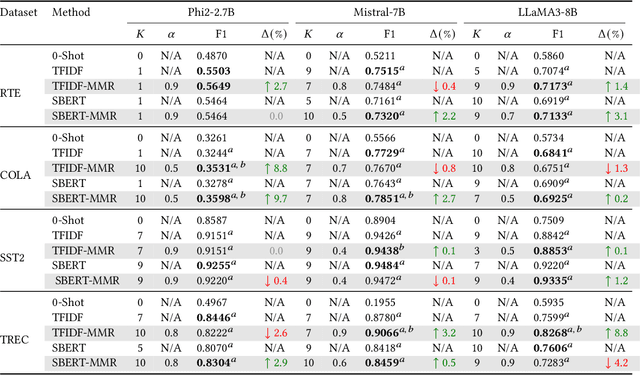
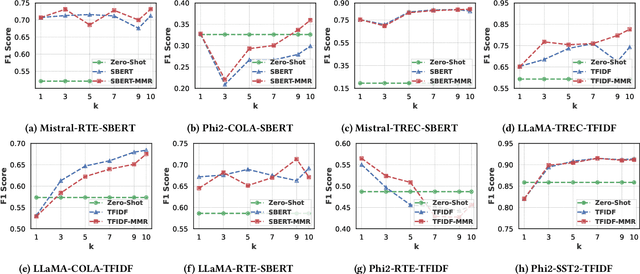
Abstract:In-Context Learning (ICL) has gained prominence due to its ability to perform tasks without requiring extensive training data and its robustness to noisy labels. A typical ICL workflow involves selecting localized examples relevant to a given input using sparse or dense embedding-based similarity functions. However, relying solely on similarity-based selection may introduce topical biases in the retrieved contexts, potentially leading to suboptimal downstream performance. We posit that reranking the retrieved context to enhance topical diversity can improve downstream task performance. To achieve this, we leverage maximum marginal relevance (MMR) which balances topical similarity with inter-example diversity. Our experimental results demonstrate that diversifying the selected examples leads to consistent improvements in downstream performance across various context sizes and similarity functions. The implementation of our approach is made available at https://github.com/janak11111/Diverse-ICL.
Is Relevance Propagated from Retriever to Generator in RAG?
Feb 20, 2025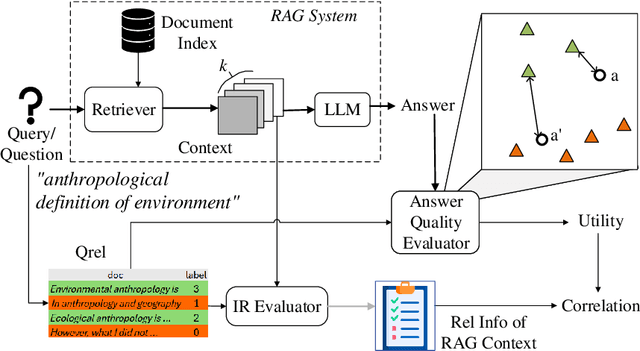
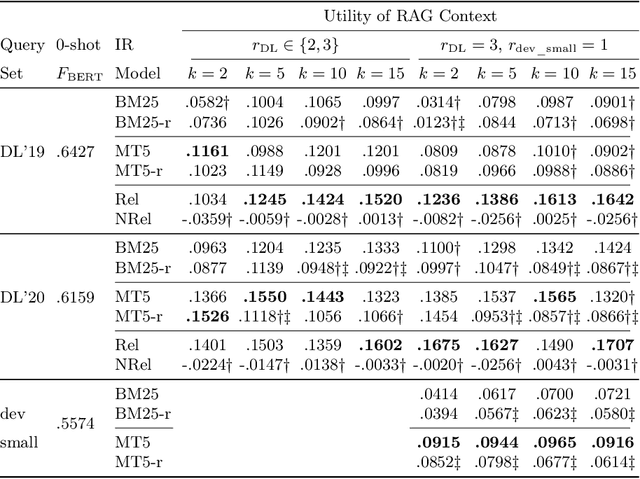
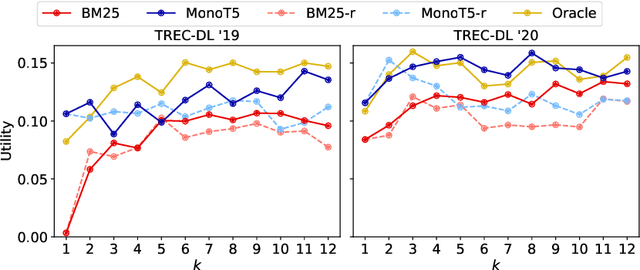
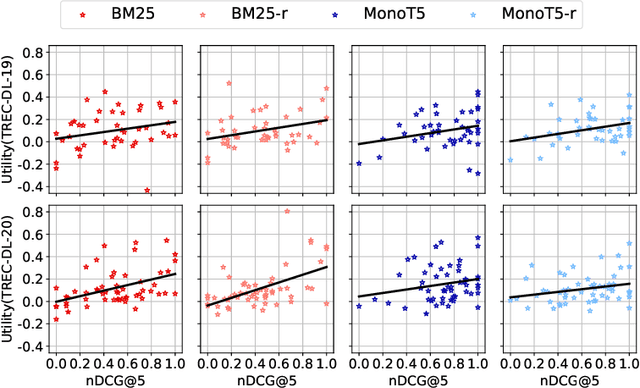
Abstract:Retrieval Augmented Generation (RAG) is a framework for incorporating external knowledge, usually in the form of a set of documents retrieved from a collection, as a part of a prompt to a large language model (LLM) to potentially improve the performance of a downstream task, such as question answering. Different from a standard retrieval task's objective of maximising the relevance of a set of top-ranked documents, a RAG system's objective is rather to maximise their total utility, where the utility of a document indicates whether including it as a part of the additional contextual information in an LLM prompt improves a downstream task. Existing studies investigate the role of the relevance of a RAG context for knowledge-intensive language tasks (KILT), where relevance essentially takes the form of answer containment. In contrast, in our work, relevance corresponds to that of topical overlap between a query and a document for an information seeking task. Specifically, we make use of an IR test collection to empirically investigate whether a RAG context comprised of topically relevant documents leads to improved downstream performance. Our experiments lead to the following findings: (a) there is a small positive correlation between relevance and utility; (b) this correlation decreases with increasing context sizes (higher values of k in k-shot); and (c) a more effective retrieval model generally leads to better downstream RAG performance.
Few-shot Pairwise Rank Prompting: An Effective Non-Parametric Retrieval Model
Sep 27, 2024Abstract:A supervised ranking model, despite its advantage of being effective, usually involves complex processing - typically multiple stages of task-specific pre-training and fine-tuning. This has motivated researchers to explore simpler pipelines leveraging large language models (LLMs) that are capable of working in a zero-shot manner. However, since zero-shot inference does not make use of a training set of pairs of queries and their relevant documents, its performance is mostly worse than that of supervised models, which are trained on such example pairs. Motivated by the existing findings that training examples generally improve zero-shot performance, in our work, we explore if this also applies to ranking models. More specifically, given a query and a pair of documents, the preference prediction task is improved by augmenting examples of preferences for similar queries from a training set. Our proposed pairwise few-shot ranker demonstrates consistent improvements over the zero-shot baseline on both in-domain (TREC DL) and out-domain (BEIR subset) retrieval benchmarks. Our method also achieves a close performance to that of a supervised model without requiring any complex training pipeline.
AlpaPICO: Extraction of PICO Frames from Clinical Trial Documents Using LLMs
Sep 15, 2024



Abstract:In recent years, there has been a surge in the publication of clinical trial reports, making it challenging to conduct systematic reviews. Automatically extracting Population, Intervention, Comparator, and Outcome (PICO) from clinical trial studies can alleviate the traditionally time-consuming process of manually scrutinizing systematic reviews. Existing approaches of PICO frame extraction involves supervised approach that relies on the existence of manually annotated data points in the form of BIO label tagging. Recent approaches, such as In-Context Learning (ICL), which has been shown to be effective for a number of downstream NLP tasks, require the use of labeled examples. In this work, we adopt ICL strategy by employing the pretrained knowledge of Large Language Models (LLMs), gathered during the pretraining phase of an LLM, to automatically extract the PICO-related terminologies from clinical trial documents in unsupervised set up to bypass the availability of large number of annotated data instances. Additionally, to showcase the highest effectiveness of LLM in oracle scenario where large number of annotated samples are available, we adopt the instruction tuning strategy by employing Low Rank Adaptation (LORA) to conduct the training of gigantic model in low resource environment for the PICO frame extraction task. Our empirical results show that our proposed ICL-based framework produces comparable results on all the version of EBM-NLP datasets and the proposed instruction tuned version of our framework produces state-of-the-art results on all the different EBM-NLP datasets. Our project is available at \url{https://github.com/shrimonmuke0202/AlpaPICO.git}.
Top-Down Partitioning for Efficient List-Wise Ranking
May 23, 2024Abstract:Large Language Models (LLMs) have significantly impacted many facets of natural language processing and information retrieval. Unlike previous encoder-based approaches, the enlarged context window of these generative models allows for ranking multiple documents at once, commonly called list-wise ranking. However, there are still limits to the number of documents that can be ranked in a single inference of the model, leading to the broad adoption of a sliding window approach to identify the k most relevant items in a ranked list. We argue that the sliding window approach is not well-suited for list-wise re-ranking because it (1) cannot be parallelized in its current form, (2) leads to redundant computational steps repeatedly re-scoring the best set of documents as it works its way up the initial ranking, and (3) prioritizes the lowest-ranked documents for scoring rather than the highest-ranked documents by taking a bottom-up approach. Motivated by these shortcomings and an initial study that shows list-wise rankers are biased towards relevant documents at the start of their context window, we propose a novel algorithm that partitions a ranking to depth k and processes documents top-down. Unlike sliding window approaches, our algorithm is inherently parallelizable due to the use of a pivot element, which can be compared to documents down to an arbitrary depth concurrently. In doing so, we reduce the number of expected inference calls by around 33% when ranking at depth 100 while matching the performance of prior approaches across multiple strong re-rankers.
"In-Context Learning" or: How I learned to stop worrying and love "Applied Information Retrieval"
May 02, 2024Abstract:With the increasing ability of large language models (LLMs), in-context learning (ICL) has evolved as a new paradigm for natural language processing (NLP), where instead of fine-tuning the parameters of an LLM specific to a downstream task with labeled examples, a small number of such examples is appended to a prompt instruction for controlling the decoder's generation process. ICL, thus, is conceptually similar to a non-parametric approach, such as $k$-NN, where the prediction for each instance essentially depends on the local topology, i.e., on a localised set of similar instances and their labels (called few-shot examples). This suggests that a test instance in ICL is analogous to a query in IR, and similar examples in ICL retrieved from a training set relate to a set of documents retrieved from a collection in IR. While standard unsupervised ranking models can be used to retrieve these few-shot examples from a training set, the effectiveness of the examples can potentially be improved by re-defining the notion of relevance specific to its utility for the downstream task, i.e., considering an example to be relevant if including it in the prompt instruction leads to a correct prediction. With this task-specific notion of relevance, it is possible to train a supervised ranking model (e.g., a bi-encoder or cross-encoder), which potentially learns to optimally select the few-shot examples. We believe that the recent advances in neural rankers can potentially find a use case for this task of optimally choosing examples for more effective downstream ICL predictions.
Exploiting Positional Bias for Query-Agnostic Generative Content in Search
May 01, 2024Abstract:In recent years, neural ranking models (NRMs) have been shown to substantially outperform their lexical counterparts in text retrieval. In traditional search pipelines, a combination of features leads to well-defined behaviour. However, as neural approaches become increasingly prevalent as the final scoring component of engines or as standalone systems, their robustness to malicious text and, more generally, semantic perturbation needs to be better understood. We posit that the transformer attention mechanism can induce exploitable defects through positional bias in search models, leading to an attack that could generalise beyond a single query or topic. We demonstrate such defects by showing that non-relevant text--such as promotional content--can be easily injected into a document without adversely affecting its position in search results. Unlike previous gradient-based attacks, we demonstrate these biases in a query-agnostic fashion. In doing so, without the knowledge of topicality, we can still reduce the negative effects of non-relevant content injection by controlling injection position. Our experiments are conducted with simulated on-topic promotional text automatically generated by prompting LLMs with topical context from target documents. We find that contextualisation of a non-relevant text further reduces negative effects whilst likely circumventing existing content filtering mechanisms. In contrast, lexical models are found to be more resilient to such content injection attacks. We then investigate a simple yet effective compensation for the weaknesses of the NRMs in search, validating our hypotheses regarding transformer bias.
 Add to Chrome
Add to Chrome Add to Firefox
Add to Firefox Add to Edge
Add to Edge